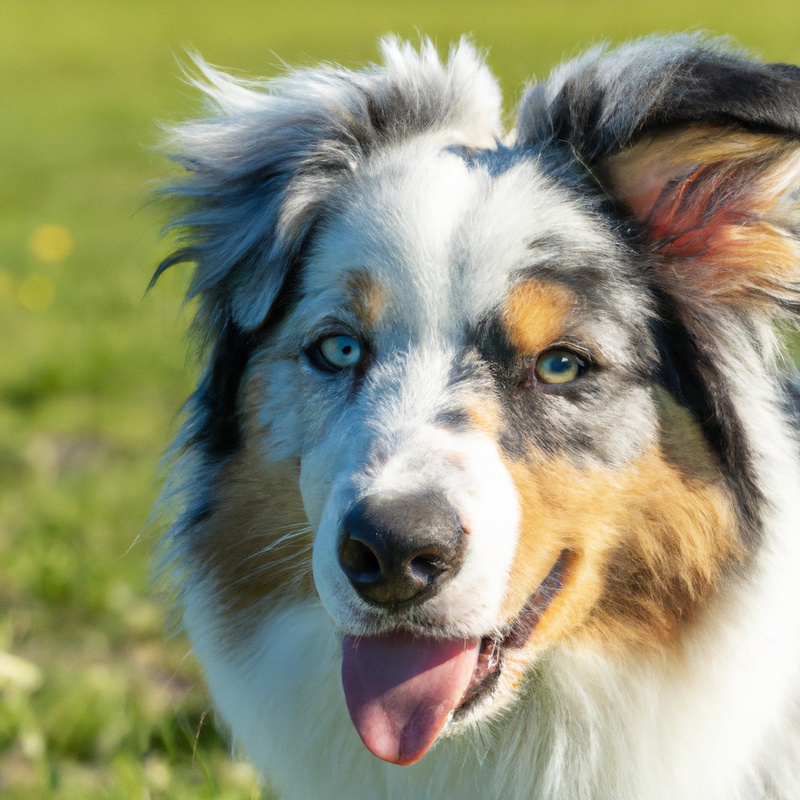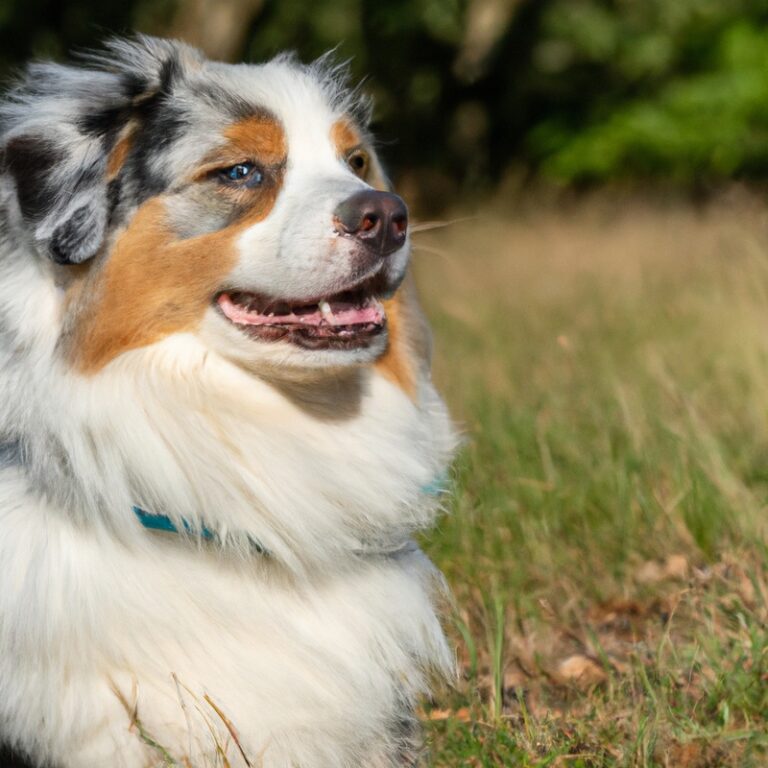How Do Australian Shepherds Handle Being Left Alone In a Yard With a Tall Fence?
Key Takeaways:
- Australian Shepherds may become anxious or bored if left alone in a yard with a tall fence for long periods of time.
- They may exhibit behavioral issues such as excessive barking, digging, or attempting to escape the yard.
- Regular exercise, mental stimulation, and social interaction can help alleviate separation anxiety in Australian Shepherds.
- Providing them with interactive toys or puzzles and considering doggy daycare or a pet sitter can minimize the negative effects of being left alone in a yard with a tall fence.
Are you a proud Australian Shepherd owner? If so, you’ve probably witnessed their boundless energy and intelligence firsthand.
But what happens when you need to leave your Aussie alone in the yard with a tall fence?
As an expert in the field, I can assure you that it’s not a one-size-fits-all answer. In this article, we’ll explore the physical characteristics, temperament, and exercise needs of Australian Shepherds to understand how they cope with being left alone.
We’ll also provide valuable tips on leaving them alone safely and address potential challenges to look out for.
So, if you’ve ever wondered how your Aussie handles solitude, keep reading to ensure their well-being and your peace of mind.
| Topic | Australian Shepherds Left Alone in a Yard with a Tall Fence |
|---|---|
| Pros | – Provides space for exercise and exploration |
| – Offers a sense of freedom and independence | |
| – Prevents access to dangerous or unfamiliar areas | |
| – Reduces escape attempts and potential dangers outside the fence | |
| Cons | – May lead to boredom and loneliness if left alone for long periods |
| – Requires regular mental stimulation and enrichment activities | |
| – Potential for excessive barking or other nuisance behaviors | |
| – Lack of human interaction and companionship |
Understanding the Australian Shepherd Breed
Physical Characteristics of Australian Shepherds
Australian Shepherds are medium-sized dogs with well-balanced bodies. They have a strong and agile build, allowing them to excel in various physical activities.
These dogs have a double coat that is weather-resistant, which helps protect them from harsh elements.
The breed’s coat comes in a variety of colors and patterns, including black, blue merle, red, and red merle. One of the distinguishing features of Australian Shepherds is their beautiful, expressive eyes.
They typically have almond-shaped eyes in various shades of blue, brown, amber, or a combination of colors.
Their ears are medium-sized and set on top of their head, usually hanging down or slightly tipped forward. Australian Shepherds have a strong and muscular neck that flows smoothly into a well-defined chest.
Their tails are often naturally bobbed or docked to a short length.
However, some Australian Shepherds are born with full-length tails. In terms of height, Australian Shepherds range from 18 to 23 inches (45 to 58 cm) at the shoulder.
The males tend to be slightly taller and heavier than females.
These dogs have a moderate to high energy level and require regular exercise and mental stimulation to thrive. Overall, the physical characteristics of Australian Shepherds make them not only visually stunning but also well-suited for various activities, including herding, agility, and obedience trials.
Their athleticism and versatility contribute to their reputation as a beloved and admired breed.

Temperament and Personality Traits of Australian Shepherds
Australian Shepherds are highly intelligent, loyal, and energetic dogs. They are known for their strong work ethic and are often used as herding and working dogs.
These dogs are highly trainable and eager to please.
However, they require plenty of mental and physical stimulation to prevent boredom and destructive behavior. Australian Shepherds are also known to be protective of their families and may exhibit some herding behaviors, such as nipping at heels.
Overall, they make great companions for active individuals or families who can provide them with the attention, exercise, and mental stimulation they need to thrive.

Exercise and Mental Stimulation Needs
Exercise and mental stimulation are essential for Australian Shepherds to lead a happy and balanced life. These dogs have a high energy level and were bred to work on farms, herding livestock, and performing other tasks.
Regular exercise helps them burn off energy and maintain their physical health.
It is recommended to provide at least an hour of vigorous exercise, such as running, hiking, or playing fetch, each day. In addition to physical exercise, Australian Shepherds also require mental stimulation to keep their intelligent minds engaged.
They thrive on learning new tasks and solving puzzles.
Interactive toys, treat-dispensing puzzles, and obedience training sessions are great ways to provide mental stimulation for these intelligent dogs. Without enough exercise and mental stimulation, Australian Shepherds can become bored, frustrated, and may display unwanted behaviors such as excessive barking, digging, or chewing.
It is crucial to fulfill their exercise and mental stimulation needs to prevent these issues.
Furthermore, Australian Shepherds enjoy engaging in activities that involve their owners. They love participating in dog sports like agility, obedience, and herding trials.
These activities not only provide physical and mental exercise but also strengthen the bond between the dog and its owner.
Factors That Affect How Australian Shepherds Handle Being Left Alone in a Yard
Age and Developmental Stage of the Australian Shepherd
Understanding the age and developmental stage of the Australian Shepherd is important when considering how they handle being left alone in a yard. Puppies and young dogs may have more energy and a higher need for attention and stimulation, which can make them more prone to restlessness and anxiety when left alone.
As they mature, Australian Shepherds typically become more independent and better at self-regulation.
However, older dogs may have different needs and may require more comfort and reassurance when left alone. It’s important to consider the specific needs and behaviors of your Australian Shepherd based on their age and developmental stage to ensure their well-being and happiness when left alone.

Previous Training and Socialization
Previous training and socialization are important factors that greatly influence how Australian Shepherds handle being left alone in a yard with a tall fence. Proper training and socialization from a young age can help them develop confidence, independence, and the ability to handle alone time.
When an Australian Shepherd has been well-trained and socialized, they are more likely to feel secure and content in their environment, making it easier for them to handle being left alone.
Without previous training and socialization, they may experience anxiety, fear, and may exhibit destructive behaviors in response to being left alone. So, it’s crucial to invest time and effort into training and socializing your Australian Shepherd to help them feel comfortable and confident when left alone in the yard.
Length and Frequency of Time Left Alone
When it comes to length and frequency of time left alone, Australian Shepherds have specific needs. These dogs are known for their high energy and strong bonds with their owners.
Leaving them alone for extended periods can lead to anxiety and behavioral issues.
It is crucial to consider the age and developmental stage of your Australian Shepherd. Puppies and young dogs require more attention and should not be left alone for long.
Even adult dogs benefit from frequent breaks and human interaction throughout the day.
The length of time can vary depending on your dog’s individual temperament and exercise needs. Remember, Australian Shepherds thrive on companionship, so finding ways to reduce their alone time is essential for their well-being.
Tips for Leaving Australian Shepherds Alone in a Yard with a Tall Fence
Gradual Exposure and Training
Gradual exposure and training are key when it comes to leaving Australian Shepherds alone in a yard with a tall fence. Start by gradually increasing the amount of time your dog spends alone in the yard.
Begin with short periods, and then gradually increase the duration over time.
During these alone periods, make sure your dog has plenty of toys and activities to keep them mentally stimulated and engaged. You can also hide treats around the yard for them to find, or use interactive puzzle toys to provide mental enrichment.
Training is also crucial for teaching your Australian Shepherd how to handle being alone in the yard.
Start by practicing basic obedience commands, such as sit, stay, and come, in a controlled and stress-free environment. Once they have mastered these commands, gradually introduce distractions to simulate real-life situations.
Remember to always reward your dog for good behavior and provide positive reinforcement.
This will help them associate being alone in the yard with positive experiences. With consistency and patience, your Australian Shepherd will learn to handle being left alone in the yard with a tall fence.
Enrichment Toys and Activities
Enrichment toys and activities can play a crucial role in keeping Australian Shepherds entertained and mentally stimulated while they are alone in a yard with a tall fence. These intelligent dogs thrive on mental challenges, so providing them with interactive puzzle toys, treat-dispensing toys, and chew toys can help alleviate boredom and prevent destructive behavior.
Activities such as hide-and-seek games with their toys or practicing obedience commands can also engage their minds and keep them mentally sharp.
Regularly rotating and introducing new toys and activities can keep them engaged and prevent them from getting bored.
Hiring a Dog Walker or Sitter
Hiring a dog walker or sitter can provide a great solution for leaving your Australian Shepherd alone in a yard with a tall fence. A dog walker or sitter can offer companionship, exercise, and mental stimulation while you are away.
They can take your dog for walks, play with them, and make sure they are well-cared for.
When hiring a dog walker or sitter, make sure to find someone who is reliable, experienced with Australian Shepherds, and trustworthy. Look for recommendations, read reviews, and meet with potential candidates to ensure a good fit.
Your Australian Shepherd will appreciate the attention and interaction they receive from a dog walker or sitter, making their alone time more enjoyable.
Potential Challenges and Issues to Consider
Separation Anxiety
Separation anxiety is a common issue among Australian Shepherds when they are left alone. It’s a condition in which dogs become distressed and anxious when separated from their owners.
When experiencing separation anxiety, Australian Shepherds may exhibit behaviors such as excessive barking, destructive chewing, and even attempts to escape the yard.
To help alleviate separation anxiety, it’s important to gradually acclimate your Australian Shepherd to being alone. Start by leaving them for short periods of time and gradually increase the duration as they become more comfortable.
Providing them with engaging toys and activities can also help distract them and keep them occupied while you’re away.
It’s important to note that separation anxiety can be a complex issue, and it may require professional help and support. If you’re struggling to address your Australian Shepherd’s separation anxiety, it’s recommended to consult a professional dog trainer or behaviorist.
They can assess the situation and provide guidance tailored to your dog’s specific needs.
Additionally, joining support groups or online communities for Australian Shepherd owners can be beneficial. These platforms allow you to connect with others who have experienced similar challenges and can offer advice and support.
Remember, addressing separation anxiety requires patience and consistency.
With time and proper training, you can help your Australian Shepherd feel more comfortable and secure when left alone in a yard with a tall fence.
Boredom and Destructive Behavior
Boredom and Destructive Behavior: Australian Shepherds are intelligent and active dogs that require mental and physical stimulation. When left alone in a yard with a tall fence for extended periods, they can become bored, leading to destructive behavior.
They may resort to digging, chewing, or excessive barking to alleviate their boredom.
To prevent this, it is important to provide plenty of toys, puzzles, and interactive games to keep them entertained. Regular exercise and mental stimulation before leaving them alone can also help reduce their boredom and destructive tendencies.
Additionally, consider hiring a dog walker or sitter to break up the monotony and give them extra attention during the day.
Noise Anxiety and Reactivity
Noise anxiety and reactivity are common challenges that Australian Shepherds may face when left alone in a yard with a tall fence. This breed is known for being sensitive to loud noises and may react strongly to unexpected sounds or disturbances.
Noise anxiety can cause Australian Shepherds to become fearful, anxious, or even exhibit aggressive behaviors.
They may bark excessively, whine, pace, or try to escape the yard in an attempt to find safety. This can be problematic not only for the dog but also for neighbors or anyone passing by.
Reactivity, on the other hand, refers to the dog’s tendency to overreact or become overly excited when confronted with certain stimuli, such as noises.
Australian Shepherds, with their high energy levels and alert nature, may display reactive behaviors like barking, lunging, or jumping when they hear loud or unfamiliar sounds. To help Australian Shepherds cope with noise anxiety and reactivity, it is important to provide them with a calm and secure environment.
This can include:
- Creating a designated safe space for your dog, such as a crate or a quiet room, where they can retreat when they feel overwhelmed by noise.
- Using positive reinforcement training techniques to desensitize and countercondition your dog to noise triggers. Gradually expose them to sounds at a low volume and reward calm behavior.
- Providing mental stimulation and enrichment activities to keep your Australian Shepherd occupied and distracted from external noises. Puzzle toys, treat-dispensing toys, and interactive games can be helpful in redirecting their attention.
- Seeking the assistance of a professional dog trainer or behaviorist who specializes in anxiety and reactivity issues. They can provide personalized guidance and develop a training plan tailored to your dog’s specific needs.
Remember, noise anxiety and reactivity are not uncommon in Australian Shepherds, but with patience, understanding, and the right approach, you can help your dog feel more calm and secure when left alone in the yard.
Seeking Professional Help and Support
Consulting a Professional Dog Trainer or Behaviorist
If you’re facing challenges with your Australian Shepherd being left alone in a yard with a tall fence, consulting a professional dog trainer or behaviorist can be incredibly helpful. These experts have extensive knowledge and experience in understanding and modifying behavior issues in dogs.
They can assess your specific situation, offer personalized guidance, and create a solid training plan to address any concerns.
Working with a professional can ensure that you are using effective and positive training techniques tailored to your Australian Shepherd’s needs. Additionally, a trainer or behaviorist can help you understand the underlying reasons for certain behaviors and provide you with strategies to manage and modify them.
So if you’re struggling with your Australian Shepherd’s behavior when left alone, don’t hesitate to reach out to a professional for assistance.
They can be a valuable resource in helping you create a happier and more balanced environment for your furry friend.
Joining Support Groups or Online Communities
Joining support groups or online communities can be highly beneficial for Australian Shepherd owners. These groups provide a space for individuals who are facing similar challenges and can offer advice, tips, and support.
By joining these communities, you can connect with other Australian Shepherd owners who have dealt with leaving their dogs alone in a yard with a tall fence.
They can share their experiences, strategies, and success stories, which can be incredibly helpful in managing your own situation. These communities often have resources such as training guides, recommended products, and expert advice.
They can provide you with valuable information on how to train and care for your Australian Shepherd when you’re not home.
In addition to learning from others, you may also find comfort and emotional support in these communities. They offer a safe space to vent your frustrations, share your concerns, and seek guidance.
Knowing that others are going through similar experiences can be reassuring and help alleviate any worries or anxieties you may have.
Joining support groups or online communities can be easily done through social media platforms or dedicated forums. Look for groups or communities specifically focused on Australian Shepherd owners or general dog ownership.
By becoming an active participant in these communities, you can gain a wealth of knowledge and support to better handle leaving your Australian Shepherd alone in a yard with a tall fence.
Final Verdict
Australian Shepherds can generally handle being left alone in a yard with a tall fence, but there are important factors to consider. Their age, training, and socialization play crucial roles in their behavior.
Providing them with exercise, mental stimulation, and enrichment toys can help prevent boredom and destructive behavior.
Additionally, hiring a dog walker or sitter can alleviate any anxiety or loneliness they may experience. It is important to be aware of potential challenges such as separation anxiety, boredom, and noise anxiety, and seek professional help if needed.
Trustworthy and reliable information is key to ensuring the well-being of your beloved Australian Shepherd.







